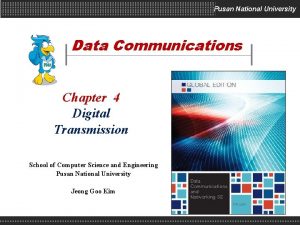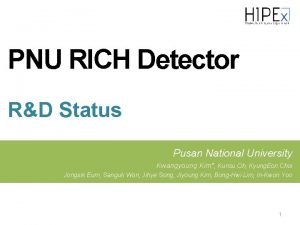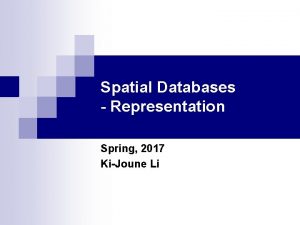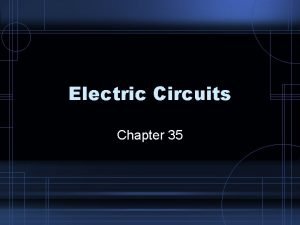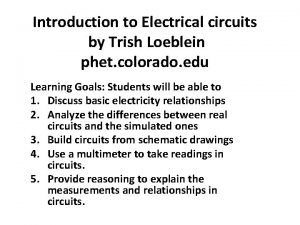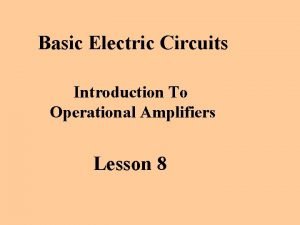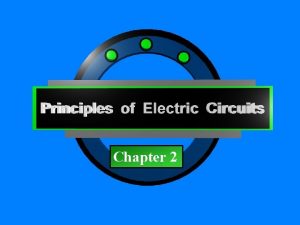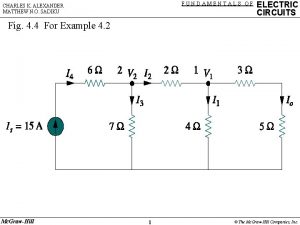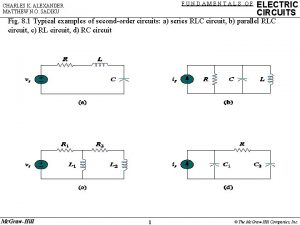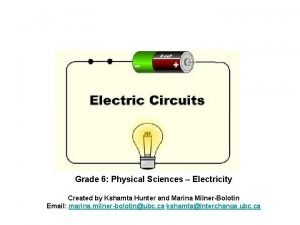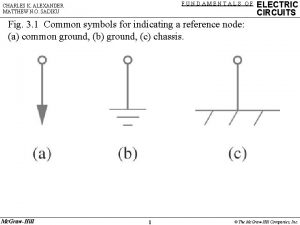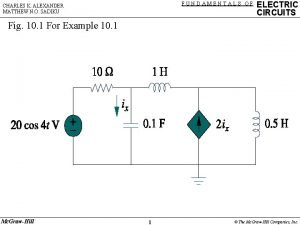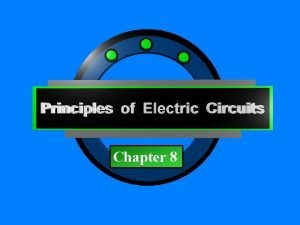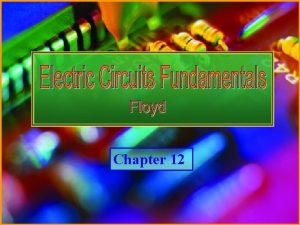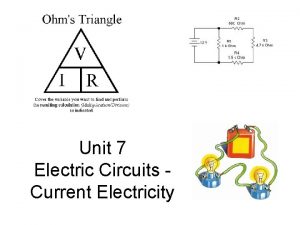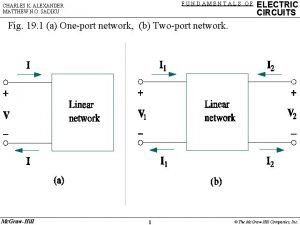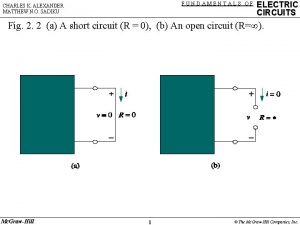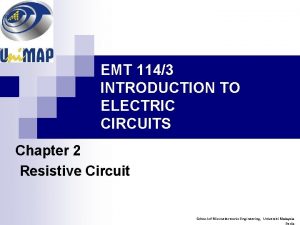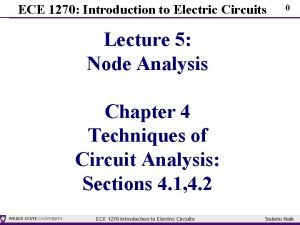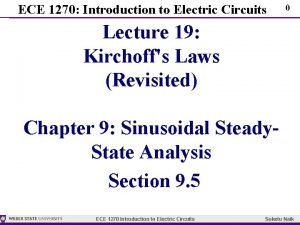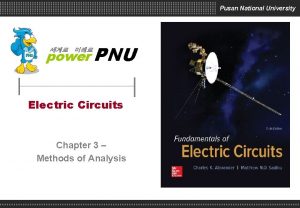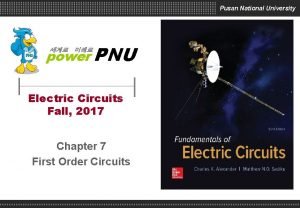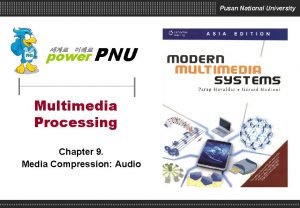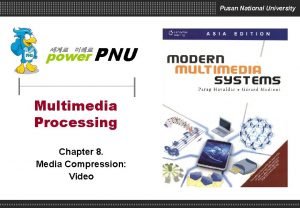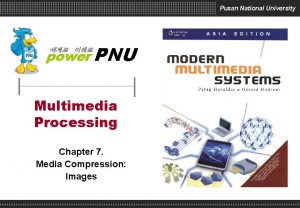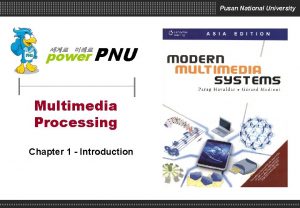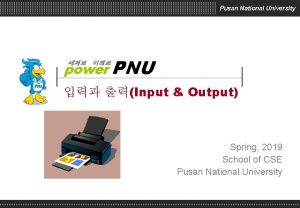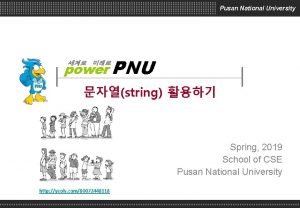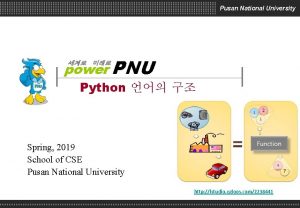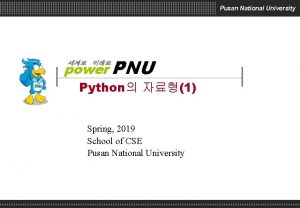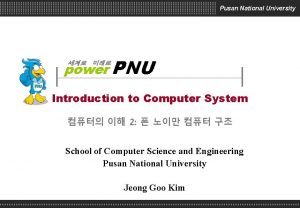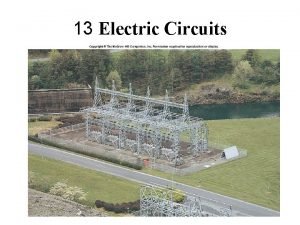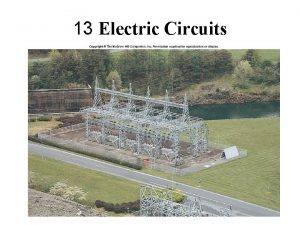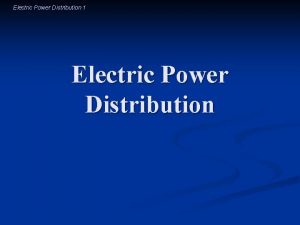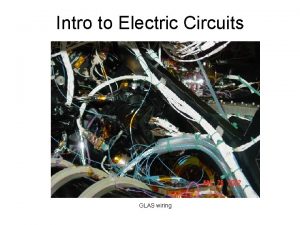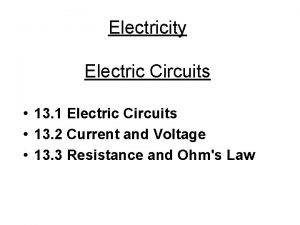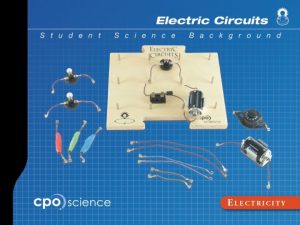Pusan National University power PNU Electric Circuits Chapter





































- Slides: 37

Pusan National University power PNU 세계로 미래로 Electric Circuits Chapter 8 Second Order Circuits

세계로 미래로 power PNU Overview The previous chapter introduced the concept of first order circuits. This chapter will expand on that with second order circuits: those that need a second order differential equation. RLC series and parallel circuits will be discussed in this context. The step response of these circuits will be covered as well. Finally the concept of duality will be discussed. Advanced Broadcasting & Communications Lab. 1

세계로 미래로 power PNU First Order Circuits Second Order Circuits The previous chapter considered circuits which only required first order differential equations to solve. However, when more than one “storage element”, i. e. capacitor or inductor is present, the equations require second order differential equations The analysis is similar to what was done with first order circuits This time, though we will only consider DC independent sources Advanced Broadcasting & Communications Lab. 2

세계로 미래로 power PNU 8. 2 Finding Initial and Final Values Working on second order system is harder than first order in terms of finding initial and final conditions. You need to know the derivatives, dv/dt and di/dt as well. Getting the polarity across a capacitor and the direction of current through an inductor is critical. Capacitor voltage and inductor current are always continuous. Advanced Broadcasting & Communications Lab. 3

세계로 미래로 power PNU 8. 2 Finding Initial and Final Values Example 8. 1 Advanced Broadcasting & Communications Lab. 4

세계로 미래로 power PNU 8. 2 Finding Initial and Final Values Example 8. 2 Advanced Broadcasting & Communications Lab. 5

세계로 미래로 power PNU 8. 3 Source Free Series RLC Circuit Consider the circuit shown. The energy at t=0 is stored in the capacitor, represented by V 0 and in the inductor, represented by I 0. Advanced Broadcasting & Communications Lab. 6

세계로 미래로 power PNU 8. 3 Source Free Series RLC Circuit Applying KVL around the loop: The integral can be eliminated by differentiation: Here you can see the second order equation that results Advanced Broadcasting & Communications Lab. 7

세계로 미래로 power PNU 8. 3 Source Free Series RLC Circuit II Two initial conditions are needed for solving this problem. The initial current is given. The first derivative of the current can also be had: Or Advanced Broadcasting & Communications Lab. 8

세계로 미래로 power PNU 8. 3 Source Free Series RLC Circuit III Based on the first order solutions, we can expect that the solution will be in exponential form. The equation will then be: For which the solutions are: Advanced Broadcasting & Communications Lab. 9

세계로 미래로 power PNU 8. 3 Source Free Series RLC Circuit Overdamped (α>ω0) When α>ω0, the system is overdamped In this case, both s 1 and s 2 are real and negative. The response of the system is: From this, we should not expect to see an oscillation Advanced Broadcasting & Communications Lab. 10

세계로 미래로 power PNU 8. 3 Source Free Series RLC Circuit Critically Damped (α=ω0) When α=ω0, the system is critically damped. The differential equation becomes: For which the solution is: There are two components to the response, an exponential decay and an exponential decay multiplied by a linear term Advanced Broadcasting & Communications Lab. 11

세계로 미래로 power PNU 8. 3 Source Free Series RLC Circuit Underdamped (α<ω0) When α<ω0, the system is considered to be underdamped In this case, the solution will be: Where and ω0 is often called the undamped natural frequency ωd is called the damped natural frequency Advanced Broadcasting & Communications Lab. 12

세계로 미래로 power PNU 8. 3 Source Free Series RLC Circuit Damping and RLC networks can be characterized by the following: 1. The behavior of these networks is captured by the idea of damping 2. Oscillatory response is possible due to the presence of two types of energy storage elements. 3. It is typically difficult to tell the difference between damped and critically damped responses. Advanced Broadcasting & Communications Lab. 13

세계로 미래로 power PNU 8. 3 Source Free Series RLC Circuit Example 8. 3 Advanced Broadcasting & Communications Lab. 14

세계로 미래로 power PNU 8. 3 Source Free Series RLC Circuit Example 8. 4 Advanced Broadcasting & Communications Lab. 15

세계로 미래로 power PNU 8. 4 Source Free Parallel RLC Circuit 8. 4 Source Free Series RLC Circuit Now let us look at parallel forms of RLC networks Consider the circuit shown Assume the initial current and voltage to be: Advanced Broadcasting & Communications Lab. 16

세계로 미래로 power PNU 8. 4 Source Free Parallel RLC Circuit Source Free Series RLC Circuit II Applying KCL to the top node we get: Taking the derivative with respect to t gives: The characteristic equation for this is: Advanced Broadcasting & Communications Lab. 17

세계로 미래로 power PNU Advanced Broadcasting & Communications Lab. 8. 4 Source Free Parallel RLC Circuit 18

세계로 미래로 power PNU Advanced Broadcasting & Communications Lab. 8. 4 Source Free Parallel RLC Circuit 19

세계로 미래로 power PNU 8. 4 Source Free Parallel RLC Circuit Source Free Series RLC Circuit III From this, we can find the roots of the characteristic equation to be: As in last time, there are three scenarios to consider. Advanced Broadcasting & Communications Lab. 20

세계로 미래로 power PNU 8. 4 Source Free Parallel RLC Circuit Damping For the overdamped case, the roots are real and negative, so the response is: For critically damped, the roots are real and equal, so the response Advanced Broadcasting & Communications Lab. 21

세계로 미래로 power PNU 8. 4 Source Free Parallel RLC Circuit Underdamped In the underdamped case, the roots are complex and so the response will be: To get the values for the constants, we need to know v(0) and dv(0)/dt. To find the second term, we use: Advanced Broadcasting & Communications Lab. 22

세계로 미래로 power PNU 8. 4 Source Free Parallel RLC Circuit Underdamped II The voltage waveforms will be similar to those shown for the series network. Note that in the series network, we first found the inductor current and then solved for the rest from that. Here we start with the capacitor voltage and similarly, solve for the other variables from that. Advanced Broadcasting & Communications Lab. 23

세계로 미래로 power PNU 8. 4 Source Free Parallel RLC Circuit Responses for Three Degrees of Damping Advanced Broadcasting & Communications Lab. 24

세계로 미래로 power PNU 8. 4 Source Free Parallel RLC Circuit Example 8. 5 Find v(t) for t>0 assuming v(0)=5 V, i(0)=0, L=1 H, and C=10 m. F. Consider R=1. 923, 5, and 6. 25Ω Advanced Broadcasting & Communications Lab. 25

세계로 미래로 power PNU 8. 4 Source Free Parallel RLC Circuit Example 8. 6 Find v(t) for t>0 Advanced Broadcasting & Communications Lab. 26

세계로 미래로 power PNU 8. 5 Step Response of a Series RLC Circuit Now let us consider what happens when a DC voltage is suddenly applied to a second order circuit. Consider the circuit shown. The switch closes at t=0. Applying KVL around the loop for t>0: but Advanced Broadcasting & Communications Lab. 27

세계로 미래로 power PNU 8. 5 Step Response of a Series RLC Circuit II Substituting for i gives: This is similar to the response for the source free version of the series circuit, except the variable is different. The solution to this equation is a combination of transient response and steady state Advanced Broadcasting & Communications Lab. 28

세계로 미래로 power PNU 8. 5 Step Response of a Series RLC Circuit III The transient response is in the same form as the solutions for the source free version. The steady state response is the final value of v(t). In this case, the capacitor voltage will equal the source voltage. Advanced Broadcasting & Communications Lab. 29

세계로 미래로 power PNU 8. 5 Step Response of a Series RLC Circuit IV The complete solutions for the three conditions of damping are: The variables A 1 and A 2 are obtained from the initial conditions, v(0) and dv(0)/dt. Advanced Broadcasting & Communications Lab. 30

세계로 미래로 power PNU 8. 5 Step Response of a Series RLC Circuit Example 8. 7 Find v(t) and i(t) for t>0, Consider R=5, 4, 1Ω Advanced Broadcasting & Communications Lab. 31

세계로 미래로 power PNU 8. 6 Step Response of a Parallel RLC Circuit The same treatment given to the parallel RLC circuit yields the same result. The response is a combination of transient and steady state responses: Here the variables A 1 and A 2 are obtained from the initial conditions, i(0) and di(0)/dt. Advanced Broadcasting & Communications Lab. 32

세계로 미래로 power PNU 8. 6 Step Response of a Parallel RLC Circuit Example 8. 8 Find i(t) and i. R(t) for t>0 Advanced Broadcasting & Communications Lab. 33

세계로 미래로 power PNU 8. 7 General Second Order Circuits The principles of the approach to solving the series and parallel forms of RLC circuits can be applied to second order circuits in general: The following four steps need to be taken: 1. First determine the initial conditions, x(0) and dx(0)/dt. 2. Turn off the independent sources and find the form of the transient response by applying KVL and KCL. Depending on the damping found, the unknown constants will be found. 3. We obtain the stead state response as: Where x( ) is the final value of x obtained in step 1 Advanced Broadcasting & Communications Lab. 34

세계로 미래로 power PNU 8. 7 General Second Order Circuits Example 8. 9 Find v(t) and i(t) for t>0 Advanced Broadcasting & Communications Lab. 35

세계로 미래로 power PNU Homework Prepare Final Exam Solve 7. 1, 7. 12, 7. 39, 7. 52, 8. 16, 8. 25, 8. 34, 8. 51 Advanced Broadcasting & Communications Lab. 36
 Pusan national university uniform
Pusan national university uniform Outlook pnu
Outlook pnu Pnu point
Pnu point Pnu korea
Pnu korea Fundamentals of electric circuits chapter 4 solutions
Fundamentals of electric circuits chapter 4 solutions Electric current
Electric current Chapter 35 electric circuits
Chapter 35 electric circuits Chapter 20 electric circuits
Chapter 20 electric circuits 9
9 Fundamentals of electric circuits chapter 7 solutions
Fundamentals of electric circuits chapter 7 solutions Chapter 35 electric circuits answers
Chapter 35 electric circuits answers Ohms law worksheet
Ohms law worksheet Chapter 35 electric circuits
Chapter 35 electric circuits Current in a parallel circuit
Current in a parallel circuit Chapter 21 electric charge and electric field
Chapter 21 electric charge and electric field Chapter 21 electric charge and electric field
Chapter 21 electric charge and electric field Electric field k constant
Electric field k constant Units of a charge
Units of a charge Phet ac circuit
Phet ac circuit Electric circuits equations
Electric circuits equations Electric circuits by james nilsson and susan riedel
Electric circuits by james nilsson and susan riedel Principles of electronic circuits
Principles of electronic circuits Three elements of electricity
Three elements of electricity Fundamentals of electric circuits
Fundamentals of electric circuits Sadiku
Sadiku Superposition electric circuits
Superposition electric circuits Electric circuits grade 6
Electric circuits grade 6 Sadiku
Sadiku Sadiku
Sadiku The circuit chapter 8 summary
The circuit chapter 8 summary Electric circuits fundamentals floyd
Electric circuits fundamentals floyd Circuit symbols
Circuit symbols Fundamentals of electric
Fundamentals of electric Fundamentals of electric
Fundamentals of electric Introduction to electric circuits
Introduction to electric circuits Find vx
Find vx Ece
Ece Ise fundamentals of electric circuits
Ise fundamentals of electric circuits
